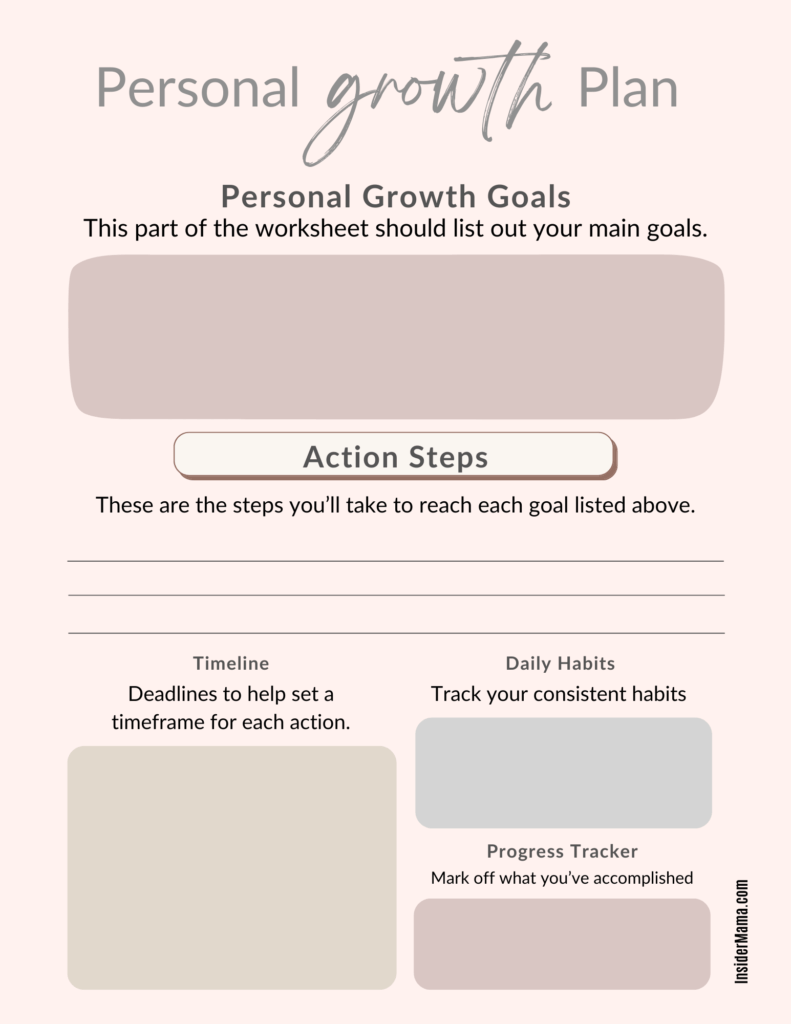We all want to grow. We set goals for ourselves, envision the future, and hope to become better versions of who we are today. But if we don’t have a solid personal growth plan in place, those goals can feel like distant dreams that never quite materialize. We need something practical to guide us—a way to map out our progress and hold ourselves accountable.
That’s where having a personal growth plan comes in. It’s like a roadmap for your life. It gives you direction and helps you break things down into smaller, manageable steps. Whether you’re looking to improve your career, relationships, or personal well-being, a good plan can help you get there without feeling overwhelmed.

This site includes affiliate links; you can check the disclosure for more details.
What Is a Personal Growth Plan?
A personal growth plan is essentially a written guide that outlines your goals and the steps you need to take to achieve them. It’s like having a personal blueprint for your life. It helps you prioritize your objectives, stay focused, and track your progress over time.
Your personal growth plan doesn’t have to be complicated or intimidating. It can be as simple as listing out your top goals and deciding on a few actions you can take each day to work toward them.
Why You Need a Personal Growth Plan
It’s easy to get caught up in the daily grind of life. Between work, kids, errands, and just trying to get through the week, personal goals can slip to the bottom of the priority list. But having a personal growth plan keeps those goals front and center.
- It helps you break down long-term goals into smaller, manageable tasks.
- It provides motivation to keep going, even when life gets hectic.
- It holds you accountable, so you don’t lose sight of what’s important.
Most importantly, a personal growth plan ensures that your growth is intentional. You’re not just hoping to improve; you have a clear path to follow.

How to Create a Personal Growth Plan
Making a personal growth plan doesn’t have to be overwhelming. Here’s how you can create one that’s tailored to your life and goals.
Step 1: Define Your Goals
Before you can create a personal growth plan, you need to know what you’re aiming for. Think about what areas of your life you’d like to improve. Your goals could be related to your career, health, personal development, relationships, or any other area that matters to you.
Write down your goals clearly. Be specific. For example, instead of writing “I want to get healthy,” try “I want to exercise three times a week and eat more whole foods.”
Step 2: Break Down Your Goals Into Smaller Tasks
Once you’ve defined your big goals, break them down into smaller tasks. This makes your goals feel more attainable and less overwhelming.
For example, if your goal is to write a book, break it down into smaller tasks like writing 500 words a day or dedicating one hour every evening to brainstorming ideas.
Think of it like building a house. You wouldn’t try to build the entire thing in one day. You start with the foundation, then add walls, and eventually put on the roof.
Breaking your goals into smaller tasks helps keep you motivated and prevents you from getting stuck.
Step 3: Set a Timeline
Having a timeline is important when you’re working toward your goals. Without a deadline, it’s easy to keep pushing things off for “tomorrow.”
Set realistic deadlines for each of your tasks and goals. It could be as simple as “I want to finish this book by the end of the year” or “I will lose five pounds by next month.”
Deadlines help create a sense of urgency, which can push you to stay on track.
Step 4: Create Daily Habits
Your personal growth plan should include daily habits that support your goals. These are small actions that you can do consistently to move closer to your bigger objectives.
For example, if one of your goals is to improve your mental health, a daily habit might be meditating for 10 minutes every morning.
Small habits might not seem like much at first, but over time, they add up. Consistency is key when it comes to personal growth.
Step 5: Monitor Your Progress
As you work through your personal growth plan, it’s important to regularly check in on your progress. Take time each week or month to review what you’ve accomplished and what still needs work.
This not only keeps you accountable, but also allows you to celebrate your successes. When you see how far you’ve come, it motivates you to keep going.
If you find that certain tasks or habits aren’t working, don’t be afraid to adjust your plan. Growth isn’t a straight line, and it’s okay to make changes as you go.
Personal Growth Plan Ideas
Everyone’s personal growth plan will look different because our goals and priorities are unique. But if you’re looking for inspiration, here are a few ideas to help you get started:
- Health Goals: Set a goal to exercise regularly, eat healthier meals, or develop a mindfulness routine.
- Career Goals: Improve your skills through courses or certifications, build a network, or work toward a promotion.
- Relationship Goals: Focus on improving communication with your partner, spending more quality time with your kids, or building deeper connections with friends.
- Financial Goals: Create a budget, save for a big purchase, or work on reducing debt.
- Personal Development Goals: Read more books, learn a new hobby, or practice self-care regularly.
Remember, the key is to make your goals personal to you. Your personal growth plan should reflect your priorities and help you focus on what matters most to you.
Using a Planner
Planners can be a great tool to help you stay organized and on track with your personal growth plan. Having everything written down in one place makes it easy to reference and keeps your goals top of mind.
Here’s how to use a planner for your personal growth plan:
- Daily Goals: Write down the small tasks or habits you want to accomplish each day.
- Weekly Check-ins: Use your planner to schedule time for weekly check-ins. Reflect on what’s working and what’s not.
- Long-Term Goals: Keep your big goals visible by writing them down at the beginning of your planner. It helps remind you what you’re working toward.
Goal Setting Planner
This undated weekly planner helps you stay organized, set life goals, and increase productivity. It supports work-life balance with a habit tracker and monthly check-ins. Featuring an eco-leather cover, stickers, and a user guide, it includes a 60-day money-back guarantee.
Creating a Personal Growth Worksheet Printable
A personal growth worksheet is a simple tool that can help guide you through the process of setting and tracking your goals. If you’re the type of person who likes having everything laid out neatly, this printable can keep things clear.
Here’s how you can structure a personal growth worksheet:
- Section for Goals: This part of the worksheet should list out your main goals. Leave space for at least 3–5 goals.
- Action Steps: Below each goal, have space for breaking it down into smaller tasks. These are the steps you’ll take to reach that goal.
- Timeline: A column for deadlines helps set a timeframe for each action.
- Daily Habits: This section tracks your consistent habits. It could be as simple as a checkbox for each day you meditate or drink enough water.
- Progress Tracker: Keep a section where you can mark off what you’ve accomplished. Checking things off feels good and keeps momentum going.
A printable worksheet makes it easy to visually see your personal growth plan, and you can even hang it up somewhere as a daily reminder. I have a free printable personal growth plan worksheet below for you to download.

The Benefits of Sticking With a Personal Growth Plan
Sticking with your personal growth plan takes commitment, but the benefits are huge. You’ll find that even small changes can make a big difference over time.
When you follow a plan, you’re giving yourself the structure to succeed. You’re taking the randomness out of growth and replacing it with clear, actionable steps.
And, most importantly, you’re prioritizing yourself. So often, we put our needs last, but a personal growth plan flips that. It says, “I’m worth investing in. My goals matter.”
With a little effort and consistency, your personal growth plan can help you become the best version of yourself.
Final Thoughts
Creating a personal growth plan doesn’t have to be complicated. Start with what matters to you. Set clear goals, break them into smaller tasks, and give yourself a realistic timeline. Track your progress and adjust as needed.
You’ve got everything you need to get started. Remember, personal growth is a journey, but with a plan in place, you’re already on the right path.
Now, go ahead and give yourself permission to invest in your future. You deserve it.




